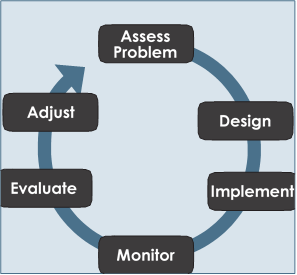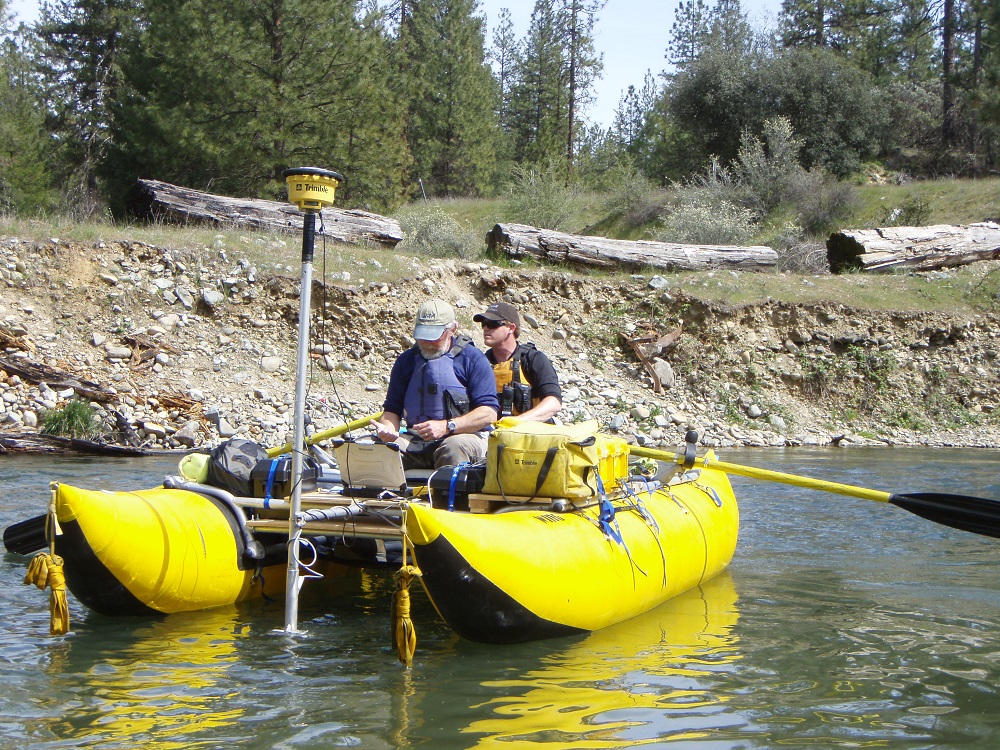The TRRP was established by the Record of Decision (2000) as an adaptive management program. The Adaptive Environmental Assessment and Management (AEAM) component of the Program is meant to provide interdisciplinary information for developing and testing hypotheses regarding how the river is responding to restoration work undertaken by the TRRP.

The Adaptive Management Process
Teams of scientists, managers, stakeholders, and policy makers use this information to update the restoration approach to best restore channel conditions and associated salmon populations. The adaptive management process is systematically repeated through time as management actions are adjusted to benefit the Trinity River and its fisheries.
KEY CONCEPTS
Alluvial river systems are complex and dynamic. Our understanding of these systems and our ability to predict future conditions are continually improving. Adaptive Environmental Assessment and Management (or simply Adaptive Management – AM) gives decision makers the ability to refine previous decisions in light of the continual increase in our knowledge and understanding of the river and catchment.

Data is collected to characterize terrain conditions, to aid in the development of site improvement plans, and to monitor restoration activities.
To adequately manage river systems for multiple use and conserve the biotic resources, monitoring of flow, sediment, geomorphic, and biological status is essential. With such data and the use of simulation models, river systems can be adaptively managed. Such informed decision-making, using water supply forecasting and predictions of system response, is within the state of the art. Establishment of an AM organization will create a focused interdisciplinary effort involving physical and biological scientists. Peer review of all analyses, project design, and monitoring is essential to establish and maintain scientific and public credibility.
DECISION MAKING UNDER ADAPTIVE MANAGEMENT
The AM approach to management relies on teams of scientists, managers, and policy makers jointly identifying and bounding management problems in quantifiable terms. In addition, the “adaptive approach to management recognizes that the information on which we base our decisions is almost always incomplete.” This recognition encourages managers to use management actions to increase our knowledge of complex systems; these actions, in turn, result in better future decisions. AM needs to not only monitor changes in the ecosystem, but also develop and test hypotheses about the causes of those changes in order to promote desired outcomes. The result is informed decisions and increasing certainty within the management process. Continued... AM is a formal, systematic, and rigorous process of learning from the outcomes of management actions, accommodating change, and improving management (31). Traditional approaches to river management are inadequate to preserve biotic community diversity. Scientific knowledge about the interactions of abiotic and biotic factors is limited, and the complexity of species interactions and interrelationships does not lend itself well to traditional single-species management approaches. The concept of ecosystem management is not new; its implementation in regulated rivers is. It is important to stress not just flow recommendations and non-flow channel alterations but also the implementation of a new paradigm of river management built on the two-decade-old concept of Adaptive Environmental Assessment and Management. An AM organization combines assessment and management. Most agency and task force structures do not allow both to go on simultaneously (33). The basis of adaptive environmental assessment and management is the need to apply lessons learned from past experience, data analysis and fine-tuning project implementation. AM combines experience with operational flexibility to respond to future monitoring and research findings and varying resource and environmental conditions. AM uses conceptual and numerical models and the scientific method to develop and test management choices. Decision makers use the results of the AM process to manage environments characterized by complexity, shifting conditions, and uncertainty about key system component relationships (25; 44). Effective management strategies must have explicit and measurable outcomes. There are few clear-cut answers to complex population biology, hydraulic, channel structure, and water quality changes. The AM process allows managers to adjust management practices (such as reservoir operations) and integrate information relating to the riverine habitats and the system response as new information becomes available. A well-designed AM organization: The concept of restoring the natural hydrograph pattern discussed by Poff et al. (47) is still debated, especially the role of hydrologic variability in sustaining the ecological integrity of river ecosystems. Stanford et al. (57) also discuss ecological integrity. An adaptive management approach to increase our knowledge and management ability should be accompanied by physical process modeling and an evaluation program to monitor the physical and biological responses. Physical and biological processes will be modeled to facilitate the AM approach to restoring the unique fish fauna by designing a program for rehabilitating the river channels to provide habitats much improved over existing conditions. Such a program, similar to the recommendations by Ligon et al. (37), needs to be supported by a rigorous prediction, monitoring and model validation program. The creation of an interdisciplinary team of scientists to run simulations, design and carry out monitoring programs, and offer recommendations to management is critical to successful implementation of the AM philosophy. RESOURCES FOR THE TRINITY RIVER
